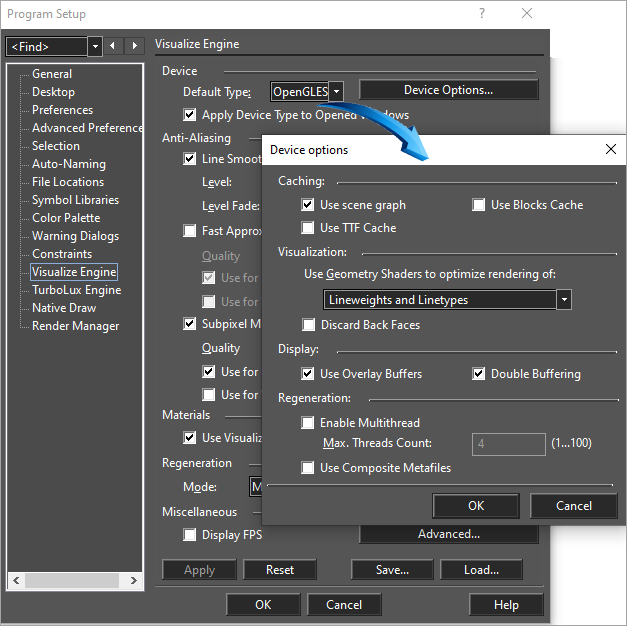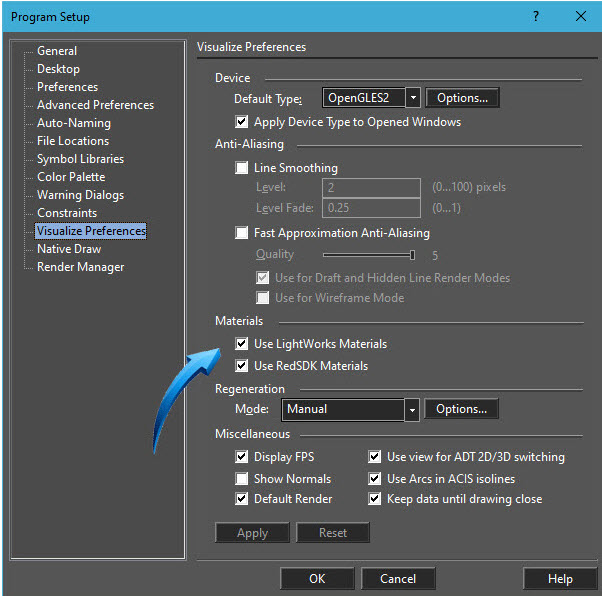Settings & Preferences
Visualize Engine Settings
Options > Program Setup > Visualize Engine
The program setup within the Visualize Engine plays a vital role in the production and rendered result of the parts.
In this section, the following recommended settings within the Visualize Engine are discussed and demonstrated.
Device
The device type is the type of processing unit used by your device. The categories of device types are shown below :
Open GL ES20
This kind of device is used by smartphones and tables, or embedded systems such as consoles and headsets. The OpenGL ES 2.0 is a derivative of the OpenGL, utilized by lower-energy consumption devices and reduced hardware capabilities.
GDI (Graphics Device Interface)
This device is mostly used by desktop applications using the Windows operating system including laptops and printing devices. This device is used for creating basic rendering of 2D shapes.
Open GL (Open Graphics Library)
This device is used in laptop and desktop computers where hardware acceleration is present. It provides a cross-platform API for creating renderings on 3-dimensional objects where design simulation and movement is required, typically found in CAD and gaming.
The Device Options settings for the default OPENGL-ES02 parameters are shown below.

Anti-Aliasing
Anti-aliasing is a technique used to reduce edge and surface distortions which occur when high-resolution images are displayed at lower resolutions.
Anti-aliasing smooths out jagged edges on curved surfaces, blending the colors and pixelations of the boundaries to produce smooth transitional surfaces.
Line smoothing
Line smoothing is done using a faceter process which balances performance (speed) against the rendered result. This is done by examining the facet edges and pattern and calibrating the result based on whether the smoothing is done using an SMAA (Sub-pixel anti-aliasing process) or a FXAA (Fast Approximate Anti-Aliasing) process.
Fast Approximation Anti-Aliasing
This process, referred to as FXAA uses an algorithm which reduces the appearance of jagged edges without impacting the speed of the rendered result.
Subpixel Morphological Anti-Aliasing
This process, commonly referred to as SMAA balances performance against rendered result by a smoothing process at subpixel level. This is done to reduce jagged edges by recognition of features such as Edge and Pattern detection.
Subpixel Morphological Anti-Aliasing is less computationally demanding than techniques which use FXAA (Fast Approximate Anti-Aliasing) or MSAA (Multisample Anti-Aliasing) as the SMAA process is less resource-demanding.
Materials
The Visualize rendering technology includes the ability to import materials contained in TurboCAD files that have been rendered either by LightWorks or RedSDK.
Currently, Visualize rendering provides color, texture, transparency map and bump maps and these parameters can be imported from LightWorks or RedSDK materials. These options are activated using Options > Program Setup > Visualize Preferences > Materials, shown below.

Display Frames per second (FPS)
This is the reading at the top right of the editor which displays the Frame Per Second. It denotes the number of frames which can be rendered per second during camera movements or visualization orbits.
Frame per Second renderings range from 30 FPS to 120 FPS with the higher value considered suitable for high-performance renderings and gaming.
See Also